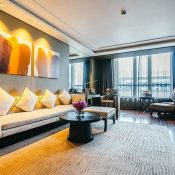
(Tips for Choosing the Right Colors in Townhouse Design)
Choosing the right colors for your townhouse can significantly impact its overall ambiance, style, and even perceived space. Color sets the mood, influences perceptions, and can make spaces feel more inviting or closed off. Here are some essential tips to guide you in selecting the most suitable colors for your townhouse design:
1. Understand the Space
Before diving into color swatches, take stock of the spaces you’re working with. Consider:
- Natural Light: Observe how the light changes throughout the day. Bright, sunlit areas may offer opportunities for bolder colors, while dim spaces can benefit from lighter shades.
- Room Function: Different rooms serve different purposes. Warm colors like reds and yellows can energize a living space, while cooler tones like blues and greens can create a restful atmosphere in bedrooms.
2. Create a Cohesive Palette
Color cohesion is crucial in townhouse design, especially when multiple rooms can be seen at once. Here are some strategies:
- Select a Base Color: Choose a neutral color that will act as a foundation throughout your townhouse. Shades like beige, gray, or off-white can create a harmonious backdrop for other colors.
- Accent Colors: Use accent colors strategically. Choose a few complementary colors that can be applied through accessories, furniture, or artwork. This creates a layered aesthetic without overwhelming the senses.
3. Utilize Color Psychology
Colors can evoke emotions and influence behavior. Keep this psychological impact in mind when selecting colors:
- Warm Colors: Reds, oranges, and yellows can stimulate energy and creativity, making them excellent for activity-focused areas like kitchens and living rooms.
- Cool Colors: Blues, greens, and purples are calming and promote relaxation, making them ideal for bedrooms and bathrooms.
- Neutrals: Balance warm and cool tones with neutral shades for versatile spaces that can adapt to different moods and occasions.
4. Consider Architectural Features
Your townhouse’s architectural elements should influence your color choices:
- Highlight Unique Features: Use color to draw attention to unique architecture, such as exposed beams or molding. A contrasting color can make these features stand out.
- Bricks and Stones: If your townhouse has brick or stone elements, choose colors that complement these materials.
5. Experiment with Textures
Color and texture interact in unique ways. Mixing different textures can add depth to your color scheme:
- Paint Finish: The type of paint finish (matte, gloss, satin) can affect how color is perceived. Glossy finishes can brighten spaces but may highlight imperfections.
- Textiles: Incorporate colored textiles (cushions, curtains, rugs) to add personality. Layering colors in fabrics can create a cozy vibe while allowing for experimentation without a long-term commitment.
6. Try Before You Commit
Always test colors in the spaces they’ll occupy. Here’s how to do it effectively:
- Swatch Samples: Purchase small sample pots and paint patches in different areas. Observe how they look at various times of day.
- Large Swatches: Consider painting larger sections to see how the color interacts with furniture and décor.
7. Stay True to Your Style
Ultimately, your home’s color scheme should reflect your personal style. Consider:
- Inspiration Sources: Gather inspiration from magazines, websites, and social media platforms like Pinterest. Look for patterns that resonate with you.
- Balance Trends with Timelessness: While it’s fun to incorporate trendy colors, ensure that your choices have longevity to avoid quick obsolescence.
8. Hire a Professional If Needed
If choosing a color scheme feels overwhelming, don’t hesitate to seek professional help. Interior designers can provide valuable insights and help you create a space that feels cohesive and stylish.
Conclusion
Choosing the right colors for your townhouse is a creative endeavor that sets the stage for your living experience. By understanding your space, applying color psychology, and experimenting with textures, you can create a harmonious and inviting atmosphere. Remember, the ultimate goal is to make the space feel like home—reflective of your style and conducive to your lifestyle. Happy designing!
Bài viết mới
Thiết Kế Nhà Đẹp: Sáng Tạo Không Gian Sống Đẳng Cấp
(Rising Demand for Townhouses: Which Trends Are Dominating the Market?)
Những điều không ai nói bạn khi lần đầu xây nhà
Thiết Kế Nhà Phố Có Gác Lửng: Khám Phá Tối Ưu Diện Tích
Thiết Kế Nội Thất Thông Minh Trong Nhà Phố: Giải Pháp Cho Không Gian Nhỏ
Danh mục
- Kiến thức (87)






